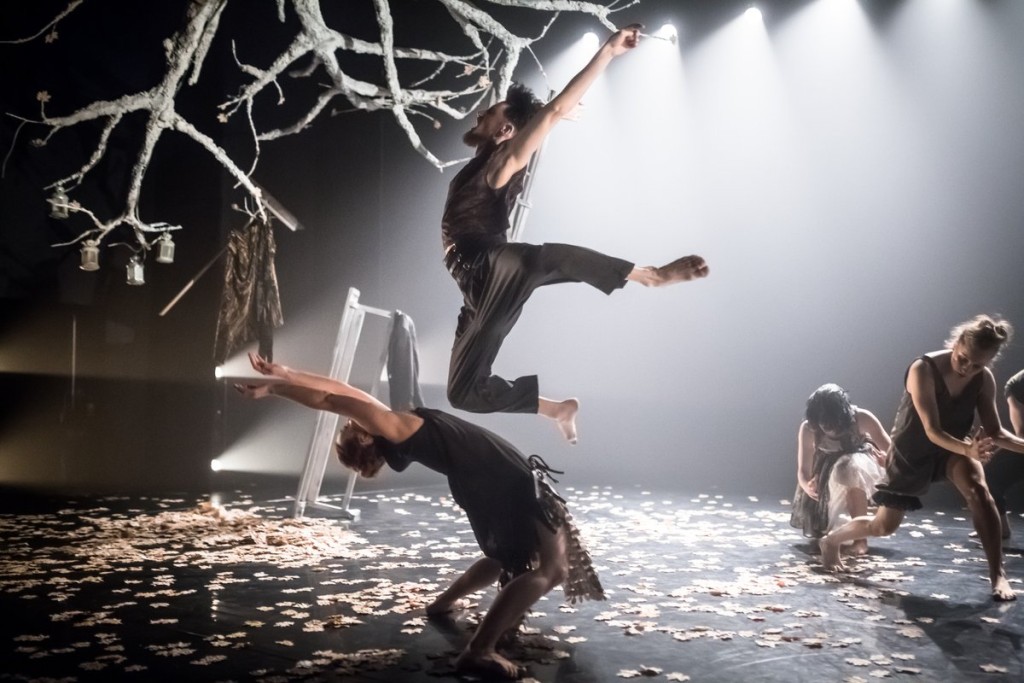Before I left for the theatre tonight I was at a neighbour’s barbeque. They asked me what I was doing tonight, and I told them I was reviewing a dance show. They rolled their eyes, laughed and made jokes about men in tights. The thing is, this wasn’t from pure ignorance. These weren’t performers who made these comments, but everyday people, who go to see plays, musicals, movies and watch plenty of TV; but are threatened by dance. The worst thing is that these views are not isolated. At tonight’s second intermission of Terra Firma I could see why people make these comments. However, after I saw Tundra, the final act of the show – I saw a working example of what dance should be and can be for everyone.
Terra Firma is the latest production of the National Dance Company of Wales. It is a collection of Four dance performances running around 30 minutes each, named Folk, The Green House, Atalaӱ and Tundra, however on the evening you are only presented with three of the four. On my evening I saw Folk, Atalaӱ and Tundra.
I would not call Terra Firma a show, it was more a collection of performances. There was no story or themes running between any of the pieces and to call it a show would entail the audience going on some form of story or emotional journey.
The programme and websites offer little insight or synopsis of these performances, apart from telling you about the cast, choreography and costumers. While this leaves everything to the eye of the audience member, having no through story makes the whole concept confusing to the audience.
Folk:
The audience was presented with an upside-down tree hanging from the ceiling and leaves on the stage. This then proceeded to a 28 minute dance with nine dancers at some points all telling different stories at the same time. As an audience member I was strained and confused trying to figure out who to look at and how I am meant to feel about what they are doing.
The highlight for this dance for me was a 1-minute section between Julia Rieder and Tim Volleman. This was beautiful and emotional and made me feel like I was watching a lovers’ quarrel. It was the first time in this piece I felt something.
This is not an insult to the dancers, who were excellent and very skilful in this piece, but more about Caroline Finn’s choreography, which I feel was written around the music she selected, rather than the music being picked to heighten the choreography and story she was telling in the piece.
Atalaӱ:
Again, similar to Folk, Mario Bermudez-Gil piece was confusing. An audience member at the bar during intermission described the piece as the following – “It was a bit like being invited to a Turkish Wedding and the waiters started dancing”. Again, not an insult to the dancers, but more to the choreography not making the audience feel anything. It didn’t emotionally have a journey or take us anywhere.
Tundra:
After the second interval I was thinking I may be being too harsh on the previous performances. However, after seeing Tundra I discovered I wasn’t being harsh enough.
This was incredible and restored my faith in Contempory Dance. Marcos Morau’s choreography is incredibly clever and well thought through, well-crafted, using all elements of performance to heighten and encourage an emotional reaction from the audience.
Joe Fletcher (Lighting Designer), Angharad Matthews (Costumers) and whoever the Sound Designer was – were just an integral apart of this team as Marcos. The whole performance cleverly uses concepts from Artaud’s Theatre of Cruelty to make the audience feel haunted, uneasy, scared and on edge. The sound scape which uses haunting Japanese folk sounds and recordings, examples of repetitive Chinese torture techniques, strings and nails down blackboards – put us on edge. The lighting using dim lights to bright strobes, black backscreens rolling up to floodlight backscreens – all deliberately to make the audience feel uneasy.
Tundra is just as much about the costumes as anything else. The opening scene of robots floating through the stage are incredible, created by the cast wearing dresses with hoop skirts attached. The ‘human caterpillar’ (As I call it) is an incredible use of costume and dance working together. Using costume, the choreography creates optical illusions on stage, wowing the audience and creating a thrilling aspect to the performance.
The performance could have been crisper and when creating optical illusions, if one dancer or two dancers are slightly off, that can ruin the whole illusion. A small thing by one or two weaker dancers can stand out in this intricate choreography.
In a competitive arts space, all competing for Arts Council of Wales funding, I personally feel that all shows should be inclusive to all audiences. The fear of producing work, such as Folk and Atalaӱ, is that it accidentally isolates people as it doesn’t emotionally make the audience feel anything, thinking they didn’t get it, because they ‘Don’t understand Dance’. This then results in them not seeing dance again and shrinks audience numbers for everyone. May I add tonight’s house was less than 20% full and had a clear majority of kids and grandparents in the audience.
Recommended to: Personal Trainers, dancers, people who can appreciate the strength and difficulty of the dancing.
Touring:
http://www.ndcwales.co.uk/en/what-s-on/terra-firma/
